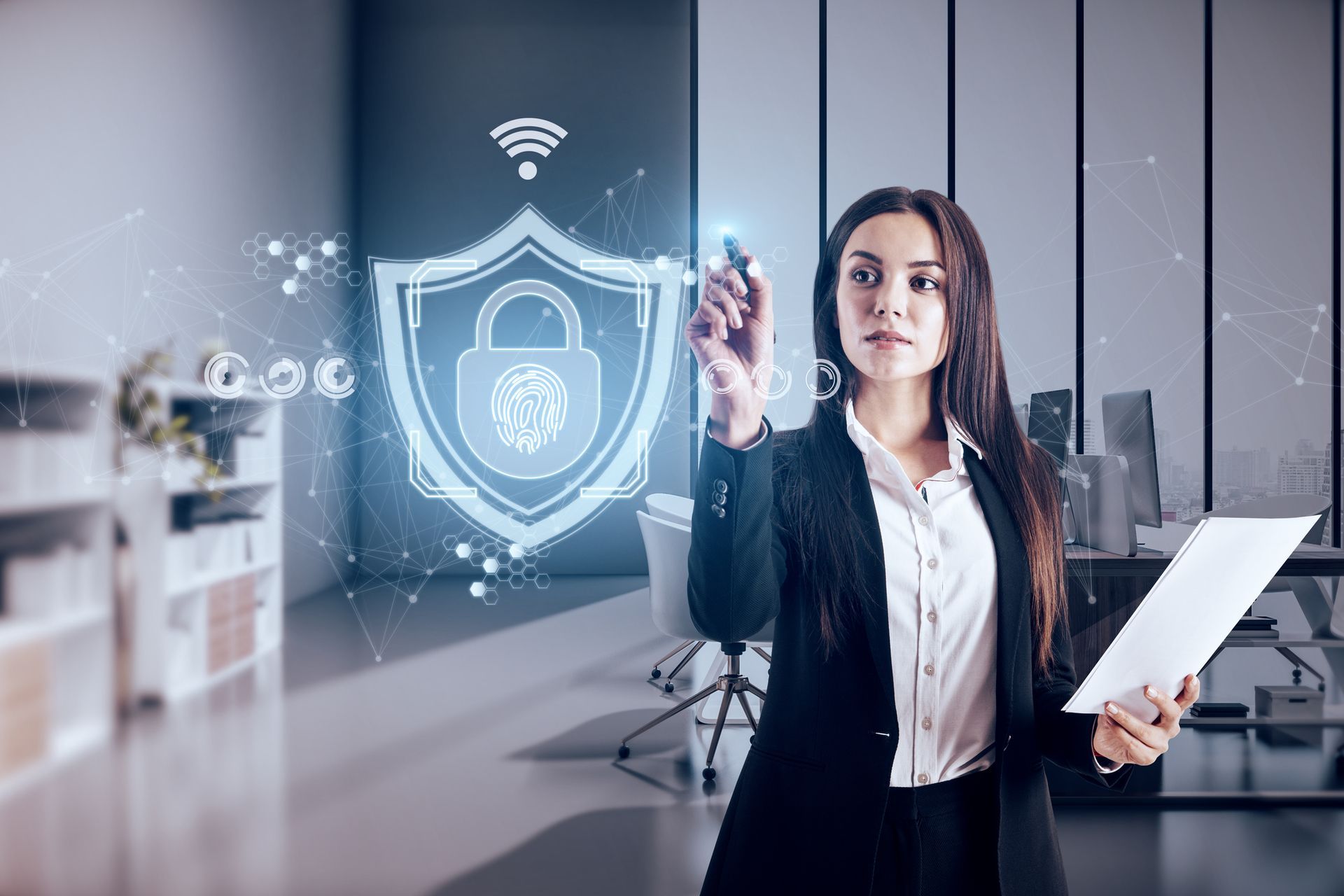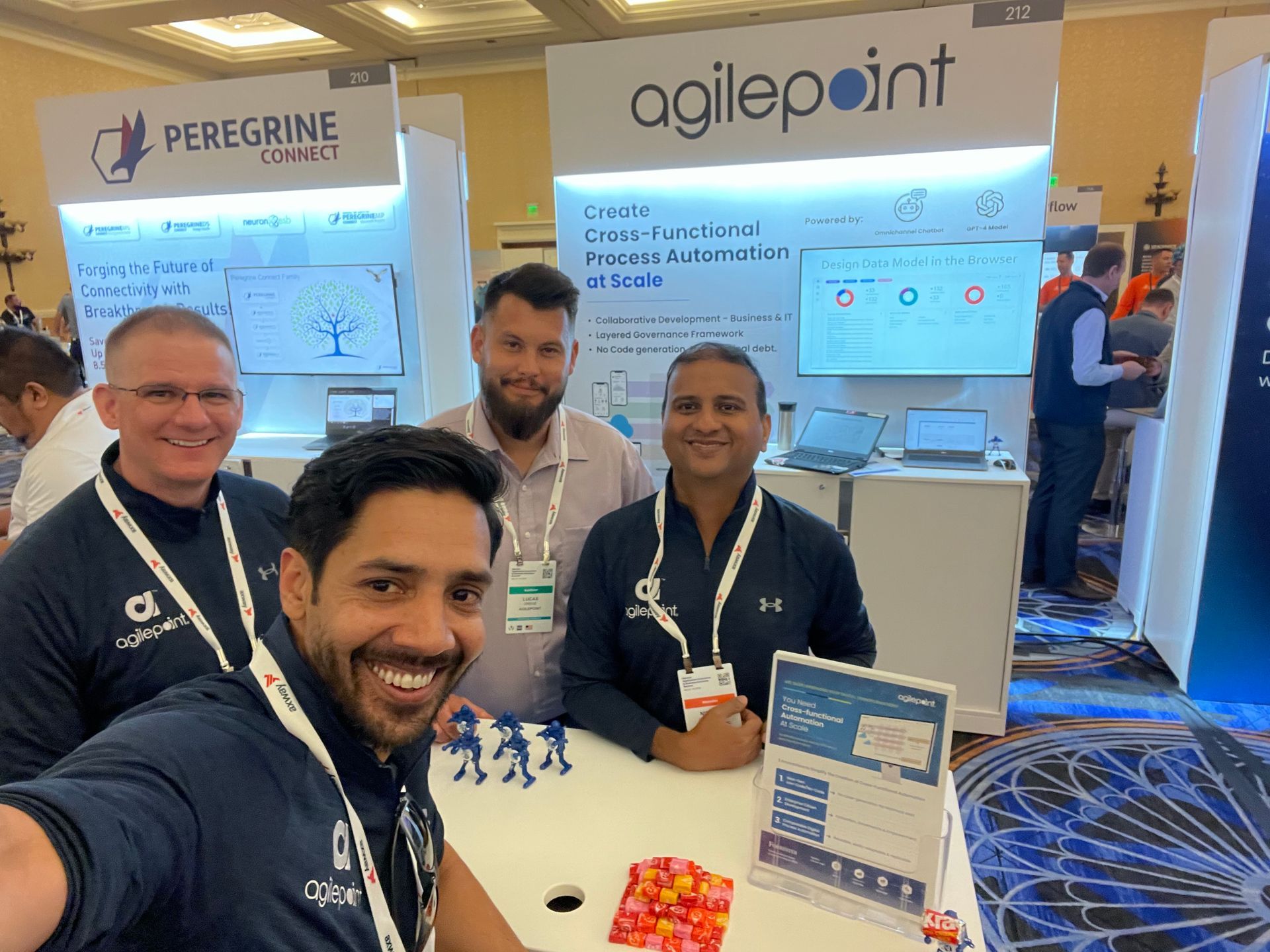AgilePoint Insights
AgilePoint Insights brings you the latest in business process automation, low-code development, business process management, digital transformation, citizen development and more!
Recent Posts
Subscribe to the Newsletter
All Insights

By Arjun Jamnadass
•
13 Jul, 2023
AgilePoint is an adaptive enterprise process automation platform. Our philosophy is that all code creates future choke points, ultimately leading to system collapse. That is why our platform is completely codeless. Allowing you to transform your business model by simplifying the processes that fundamentally underpin the applications you are running and making your organization faster, more secure, resilient, and fully adaptive. We save our clients $ 32 million or an ROI of over 400% on average. For more of our amazing result metrics, see " Total Economic Impact of AgilePoint." Introduction Transformation Trailblazer AgilePoint has emerged as a visionary trailblazer in the realm of digital transformation, offering a powerful adaptive process automation platform for enterprises. Stemming from lessons learned during the turbulent period of the dot-com bubble, where high-profile failures highlighted the critical need for agility and resilience, AgilePoint set out to empower organizations to react and respond quickly and continuously to a relentlessly changing landscape. The Codeless Differentiator Today, AgilePoint remains the preferred digital transformation platform for many global organizations, thanks to its codeless architecture delivering unrivaled agility and cost efficiency. Remarkably, even after two decades, numerous customers continue to rely on AgilePoint as a core capability and key competitive differentiator. We pride ourselves in the long-term relationships we maintain with our clients. Today, where companies stay an average of 5 years with a technology vendor, many of AgilePoint customers have been with us for up to two decades. Speed, adaptability, transparency, cost efficiency, security, trust, and confidence. These are the reasons our customers stay. The following experiences come from Fortune 100s and publicly listed companies, including a longtime customer where AgilePoint enabled a successful €166 billion merger. 1. Accelerated Development and Adaptation AgilePoint enables organizations to be adaptive without the significant upfront investment. It enables the rapid deployment of highly adaptable business solutions and gives organizations the ability to evolve them in real-time to cater to emerging opportunities and continually drive towards better customer outcomes and product-market fit. 1.1 Speed "If a project is two years long, then we can't spend six months building an application. We need to build it in two to three weeks. With AgilePoint, we can." These are the words of a director at a Fortune 100 Engineering firm that has been with AgilePoint for 14 years. His comment highlights their need for rapid development cycles essential for quick turnaround initiatives. Indeed, with a stream of constantly evolving requirements, the firm needed a platform that would allow them to ramp up and put into production tailored solutions as quickly as possible. 1.2 Continuously adaptation But they also wanted the ability to adapt these solutions continuously and have the flexibility to bespoke them for specific customer projects rather than halting production lines and redesigning solutions from the ground up to cater to specific customer requirements. "The flexibility to adapt is crucial." as stated by the same director, "Changes are needed because we are a project company. [The business] changes [and] the rules and people constantly change. So, we needed something flexible." 1.3 Keeping pace without breaking the bank AgilePoint has provided the essential capabilities this Fortune 100 engineering firm has needed all these years to keep pace with high market demand while delighting its customers with highly personalized solutions without breaking the bank. Henry Ford famously said, “Any customer can have a car painted any color that he wants so long as it is black.” Indeed, the entire production line would have had to be shut down to accommodate a different color. Not so for this engineering firm. 2. Transparent, Adaptable Automations 2.1 Lengthy process cycles, lack of visibility, and non-compliance A spokesperson from one of the world’s largest defense companies, and an AgilePoint customer for the last 17 years, highlighted the challenges their organization faced before AgilePoint, including lengthy process cycles, lack of visibility, and non-compliance with regulations. 2.2 Struggling to adapt Before AgilePoint, they were struggling to evergreen their cross-functional automation (complex, end-to-end, cross-departmental automated workflows) as their incumbent platform could not provide them with the flexibility and dynamism they needed to prepare for and deliver a massive overhaul of their operations (they were amid a large, time-sensitive merger) while keeping in line with regulatory requirements. The company needed more transparency concerning its automation processes, which significantly hampered its ability to pinpoint compliance issues. The rapidly evolving landscape continually outpaced their responsiveness. Business users found it challenging to comprehend, much less modify, these automated procedures, resulting in frequent regulatory non-compliance. Consequently, their solutions needed to be more relevant and aligned before they could be tended to by the IT department. 2.3 Time lost "We found out that time loss in two ways. One, the process cycle was very long. And two, the business users needed to control where anything stood. We found many of our processes did not follow the official and approved procedures." 2.4 The Gamechanger After extremely lengthy due diligence, AgilePoint was chosen as the platform to handle the defense company’s rapidly evolving operations and underpin the post-merger operating model. Indeed, the platform gave them the visibility they needed to stay on top of and compliant with a changing regulatory landscape. It enabled them to adapt their process automation in real time. Ultimately, the high level of transparency of their process automation and ease of adapting them on the fly proved to be the game-changers for the defense company. 3. Simple Modernization 3.1 Straightforward and painless A publicly listed German Leasing company and an AgilePoint customer for over 15 years had considered replacing AgilePoint as their enterprise automation platform a few times, driven by internal strategy initiatives to consolidate their technology footprint. However, they decided to stick with AgilePoint when it became evident that alternative solutions could not match the “straightforward and painless” upgrade and modernization experience. 3.2 No additional cost AgilePoint never charges for the ongoing, continuous modernization of the platform, a key driver in sustaining prolonged customer loyalty. Nor does the modernization require expensive implementation partners to carry out upgrades. 3.3 The alternatives are expensive A vice president at a Media company noted that their previous platform required costly implementation partners to manage changes and upgrades. He stated, "[Our old platform] was costly because we didn't have developers for it. We always needed an implementation partner, meaning we had to pay both the partner and the licenses [for our old automation platform]." 3.4 Avoid heavy investments Additionally, AgilePoint's integrations are not hard-coded, meaning that customers avoid having to invest heavily in ensuring continued interoperability and harmony across the IT ecosystem with each new AgilePoint release, or with any changes they make to their underlying IT infrastructure. 3.5 Disruption-free, seamless upgrades The platform's core principles are simple, continuous modernization without predatory pricing schemes. With its codeless architecture, AgilePoint has ensured that, for the past 15 years, the German Leasing company's business experiences a disruption-free, seamless upgrade to the latest release. Downtime is virtually negligible. As a result, the publicly listed company had the peace of mind that their business-critical solutions and automation were kept safe, secure, and up to date at no additional cost. 4. Continuous Innovation 4.1 Compatibility AgilePoint's commitment to sustaining long-term value through innovation resonated strongly with customers. A business manager at a global Non-Profit organization expressed concern about other vendors' lack of product advancement. In contrast, AgilePoint actively ensures its product retains its robust security credentials, remains compatible with evolving technology platforms, and regularly delivers the latest capabilities and enhanced functionality into the platform. 4.2 Keeping pace with technology According to the director of the Fortune 100 Engineering firm, "AgilePoint helped us because the technology advanced fast." This focus on continuous technological advancement ensures that organizations can continue to rely on AgilePoint to keep pace with the latest industry standards and competitive pressures." The same business manager stated, "AgilePoint made it possible for us to stay updated with the changing digital transformation happening around the globe. AgilePoint has made it possible for us to do things that we wouldn't have thought of." 4.3 Groundbreaking and robust The Non-Profit organization and the Engineering firm, both customers for over a decade, continue to benefit from leveraging AgilePoint across their core business operations. Drawing on cross-industry best practices and incorporating the latest trends and innovative thinking, AgilePoint continually infuses the platform with ground-breaking features and robust capabilities. This steadfast commitment to technological advancement enhances its customers' long-term experience and outcomes. 5. Transparent, predictable pricing 5.1 Transparent and cost-efficient licensing A Fortune 100 technology and manufacturing conglomerate, and an AgilePoint customer for over a decade, illustrates the power of transparent and cost-efficient licensing in the digital transformation journey. The organization built a vast portfolio of deeply customized, mission-critical workflow on-premise automations. It was ready to harness the benefits of the cloud. The objective was clear: maintaining the most secure processes on-premise while gradually transitioning all other operations to the cloud. 5.2 Multiple licenses needed Their incumbent vendor, however, threw them a curveball. Accommodating the conglomerate’s phased migration plan called for multiple licenses for the different versions of their on-premise and cloud platforms, thereby inflating costs considerably. This predicament, by no means an isolated case, underscores the need for transparent, cost-effective licensing agreements that facilitate rather than penalize growth, and here, again, is why AgilePoint maintains enduring relationships with its customers. 5.3 Expensive rebuild In the conglomerate’s case, not only did they have to effectively double their licensing spend to handle both on-premise and cloud operations, but it transpired that migrating their on-premise workflows to the cloud required an extensive technical rebuild. They were forced to decide; do they retain their heavily customized, business-critical workflows on-premise or undertake the substantial task of process rebuilding for cloud migration. Only a single license required Ultimately, the conglomerate moved to AgilePoint to handle its workflow automations. AgilePoint requires a single license, regardless of whether customers operate on-premise, in the cloud, or straddle both environments. With AgilePoint's codeless architecture, the conglomerate could rapidly recreate its workflow automations and maintain them on-premise and in the cloud with a single license, knowing they could seamlessly migrate them between the two without rebuilding everything. It is the essence of AgilePoint's customer-centric approach - delivering cost transparency, efficiency, and maximum flexibility. The Power of Codeless Architecture The success and longevity of AgilePoint as a trusted platform for customers over the years can be attributed to its codeless architecture. AgilePoint recognized, way back in 2003, that code creates technical debt and that this debt inevitably saps competitiveness, limits agility, and slows innovation, ultimately leading to system collapse. As author and software engineer Martin Fowler said, “Technical debt is not just a cost; it’s also a risk. It’s a risk that your system will fail at a critical moment, you won’t be able to deliver what your customers need, or you’ll lose your best engineers because they’re frustrated with working on a mess.” And managing technical debt is expensive. According to a McKinsey survey, CIOs reported that 10 to 20% of the technology budget dedicated to new products is diverted to resolving issues related to tech debt. A study by Stripe found that developers spend an average of 33% of their time dealing with technical debt. Worldwide, this adds up to a $3 trillion hit on global GDP. AgilePoint’s codeless architecture was created to circumvent technical debt. To bypass the need for hard-coded business solutions that are complex and expensive to update. Coupled with an intuitive front-end and model-driven, declarative approach to building solutions that caters for non-technical users, the codeless architecture is exposed outside of the IT department, enabling businesses to quickly respond to changing needs and emerging opportunities without having to resort to writing even a single line of code. In my entire IT and business experience, I think AgilePoint was one of the best decisions that our organization ever made. As AgilePoint customers testify to its transformative power and the profound impact it has on their operations, it solidifies its position as a platform of choice for some of the world’s leading organizations seeking continuous, sustainable digital transformation. In the words of one AgilePoint customer representative "In my entire IT and business experience, I think AgilePoint was one of the best decisions that our organization ever made."

By Sharjeel Sohaib
•
08 May, 2023
Digital transformation has become a cliché. Still, it is crucial for mature and large organizations to remain competitive and relevant in the market. You may compare Digital transformation to the process of remodeling a house. Just as remodeling a house involves updating and upgrading different aspects of the home to meet modern standards and improve its overall functionality, digital transformation involves updating and upgrading a company's processes, systems, and technologies to meet current business requirements and improve its overall efficiency and effectiveness. In both cases, the goal is to create a more modern and functional environment that can better meet the needs of its inhabitants or users. Just as a home remodel might involve updating the plumbing, electrical wiring, and appliances to improve the overall comfort and convenience of the space, digital transformation might include implementing new software, updating IT infrastructure, and improving data analytics to enhance the company's operations and competitiveness in the market. Overall, digital transformation is a complex and ongoing process that requires a comprehensive approach and a commitment to continuous improvement. It may involve integrating digital technologies into all aspects of an organization to fundamentally change how it operates and delivers value to its customers. Or modernization of part of operations, like finance, supply chain, or compliance. Ultimately, digital transformation enables organizations to stay competitive and thrive in a volatile business environment. Below we unpack why digital transformation projects fail and why winners win in their Digital Transformation initiatives. Why Does Digital Transformation Mostly Lead to Failure? According to studies by McKinsey, more than 70% of digital transformations lead to failures, while the success rate of tech-savvy industries is around 24%. Companies with less than 100 employees are 2.7x more likely to achieve success in digital transformation than those with 50,000 or more employees. “ There is no alternative to digital transformation. Visionary companies will carve out new strategic options for themselves — those that don’t adapt will fail .” Jeff Bezos, founder, and CEO of Amazon. There’s no denying that digital transformation is challenging as you need to master continued innovation to leverage new technologies like AI, IoT, Digital Process Automation, and data analytics. However, triggers keep varying as sometimes you may need to meet the change in customer expectations or consolidate an organization after a merger. These fluctuating needs require companies to adopt flexible, governance-ready, and innovative technologies. Below we list which factors determine the success and you can win in the race to digitally transform operations. Critical Reasons Why Winners Win? Having the right tech in place is only one part of the story, and the crucial part is how companies utilize this technology to support changes is the deciding factor of a successful digital transformation. Deploying the right tech-savvy leaders Adding the right leaders at the right places in the hierarchy is one of the key factors in digital transformation. Senior leaders must be more involved in the transformation journey. Many organizations have emphasized how engaging a chief digital officer (CDO) resulted in 1.6 times higher chance than others to report a successful digital transformation. Selecting a clear goal and transformation candidate A vague idea of succeeding in digital transformation doesn't cut it. Selecting a clear use case for a digital transformation project is essential to ensure that the project is relevant, achievable, and adds value to the organization. It helps to define the project's scope and expected outcomes, build support from stakeholders, and align the project with the company's strategic outcome it plans to achieve. Bridge the gap between legacy and modern tech platforms Another essential factor is engaging integrators and technology-innovation managers, which helps bridge the gaps between traditional and modern technology solutions within an enterprise. Below we list five pillars of Digital Transformation journey, from talent development and reduction in technical debt to innovation across departments and agile governance. Five Pillars of Digital Transformation 1) Talent development Invest in talent acquisition and retention strategies that align with your team’s digital transformation goals and objectives. World Economic Forum estimates that by 2024, 40% of workers will need up to six months of reskilling, and 94% of business leaders anticipate their employees to acquire new skills. Low-Code/No-Code and Citizen Development platforms can help upskill workers. For example, GC-SDA, an AgilePoint customer, trained its non-IT staff for application development. Brian Schimpf, formerly a Business Analyst (BA) and Citizen Developer at GC-SDA, studied criminal justice and project management. His manager helped Brian acquire and polish his digital skills by training him on the AgilePoint platform. It allowed the organization to upskill the internal workforce to develop in-house apps. It is just one example that shows how you can upskill and train employees on the latest technologies like business intelligence (BI), AI, IoT, and digital process automation. If you are a large team/organization, you might have to establish digital upskilling and reskilling program to equip employees with the necessary skills. Project Management Institute (PMI) offers a range of Citizen Developer courses to help your team upskill and reskill in this emerging tech. 2) Culture of innovation and continuous learning inspires creativity and experimentation: By encouraging continuous learning, you can retain employees longer than the industry average. Hence, technology becomes an avenue to foster creativity and participation as your team members develop new solutions. 3) Reducing Technical Debt As part of your Digital Transformation journey, you may thoroughly audit the organization's legacy systems and infrastructure to identify areas that require modernization and optimization. We still come across prospects and customers running their operations through Excel. Hence, you can even start your digitalization journey with Excel . Assessing platform fit is vital to reducing technical debt and modernizing your systems and processes. The platform you choose to enable digital transformation should support a range of use cases. You may start with upgrading your SharePoint workflows, moving on to cloud-enablement of existing apps, and building greenfield app projects. Develop a phased approach to legacy system modernization that prioritizes critical systems and processes. We also call it the 'proof-of-value' approach instead of proof-of-concept, the former being rooted in identifying modernization projects that provide the best ROI. 4) Innovation across Departments Another trend is to create cross-functional teams to foster collaboration and innovation across departments. It has become a significant theme for new digital transformation projects as IT leaders are expected to build cross-functional solutions that span horizontally across the whole organization, even to its partners and subsidiaries. To understand more about creating cross-departmental solutions (that provide higher ROI) and knocking down traditional silos, you may check out our session post on “ Can Citizen Development overcome the great divide between business and IT ”? 5) Agile Governance As you start contemplating digital transformation use cases for mature organizations with high compliance and reporting requirements, choosing platforms that support your compliance needs becomes crucial. Apart from establishing clear guidelines and protocols for decision-making, risk management, and resource allocation in transformation projects, you may probe into the transformation platform’s governance tooling. For instance, here’s a video blog explaining the governance model of AgilePoint . It may give ideas about how to approach governance, even in the case of other platforms. Fig 2- Layered Enterprise Governance Framework

05 May, 2023
They say Business Process Management (BPM) is " a discipline that sounds great on paper but is difficult to realize in practice ." Legacy BPM platforms are difficult to use, and projects take an eternity to finish. Other limitations also play a part in limiting their utility. If we dig deeper, traditional BPM approaches tend to be project-oriented, focus on optimizing individual processes, and often lead to a business-IT divide. However, agility and digital transformation are the name of the game. Therefore, tech leaders are turning to a new breed of Low-Code Business Process Management platforms that have a modern user experience and help address the challenges mentioned above with a new toolset that covers six broad areas: Intelligent process modeling to build a seamless business process Continuous Improvement (CI) based on Low-Code/No-Code capabilities of the BPM platform Analytics that provide deeper insights into processes and apps Event Processing that enables goal-driven business processes Citizen Development support Native support for mobile development Moreover, modern BPM systems are based on an open architecture allowing easy integration with other systems and applications. Just this ability to play well with other enterprise systems and homegrown solutions makes a considerable difference in maximizing the ROI of your BPM initiatives. Let's turn to the benefits of a modern BPM platform. The Benefits of a Modern BPM for Business Leaders Agility: A modern BPM system enhances agility by allowing organizations to modify real-time processes in response to changes in the business environment (e.g., a new regulation, trade restrictions, or a pandemic). For instance, a logistics company can use a BPM platform to quickly adjust its delivery processes to accommodate changes in customer demand or shipping routes. The platform's advanced analytics can also provide insights into emerging trends, enabling the company to remain responsive and gain a competitive edge. Customer Experience: A modern BPM platform enhances the customer experience by improving the user experience (UX) of the internal processes that drive customer-facing services. For instance, a utility company can use a BPM system to streamline its billing process, making it easier for customers to understand and pay their bills. The platform's process improvement tools continuously improve the billing process, leading to a better customer experience. Adaptation : Modern BPM platforms allow businesses to quickly adapt and innovate their processes by providing a flexible and user-friendly interface. For instance, a retail company uses a BPM platform to modify its supply chain process to include new suppliers, change delivery routes, or update inventory management. It enables the company to respond to changing market demands, innovate operations, and remain competitive. Collaboration: A modern BPM platform fosters business-IT collaboration through a shared process design, testing, and implementation platform. For example, a healthcare org can collaborate on a new patient intake process that integrates with its EHR system, leveraging domain knowledge from business users and technical expertise from the IT team. Macabbi Healthcare Adopts Process Modernization Technology Process Improvement: A modern BPM platform aids process improvement by providing tools for process analysis, monitoring, and optimization. For example, a manufacturing company can use a BPM system to analyze its production process, identify bottlenecks and inefficiencies, and optimize the process to improve quality and reduce costs. The platform also allows for continuous monitoring and refinement of the process, ensuring ongoing improvement. AgilePoint as a Solution for Modern BPM AgilePoint is a global software company headquartered in Mountain View, California. Its core product, AgilePoint NX, is a low-code platform transforming how organizations approach application development and process automation. With a scalable, cloud-ready architecture, AgilePoint NX enables large organizations to build and maintain applications easily, putting them at the forefront of digital transformation. AgilePoint's pre-built connectors and integrations with other systems , such as ERPs, RPA, and CRMs, and its REST API helps integrate new solutions with existing systems and automate complex workflows quickly. It enables organizations to streamline operations and improve efficiency, resulting in cost savings and better customer experiences. Another critical feature of AgilePoint is its integration with AI/ML services, allowing users to incorporate intelligent decision-making and automation capabilities into their apps. The AgilePoint platform integrates out of the box with the following: Azure Machine Learning Amazon Machine Learning Google Cognitive Services Microsoft Cognitive Services By leveraging AI/ML services within their AgilePoint apps and processes, teams can identify patterns and insights, and make data-driven decisions, all of which are essential for driving digital transformation. Implementing modern BPM with AgilePoint The case of Eneco is a clear example of how AgilePoint was used to adopt a modern BPM platform and drive digital transformation in the Dutch energy provider's Smart Home Toon Thermostat division . Eneco utilized AgilePoint's Business Process Automation (BPA) engine to streamline its work processes and improve the order fulfillment process. Eneco faced challenges with its customized solution, including a 'contact center' to 'billing process' under one extensive application. With AgilePoint, Eneco could orchestrate and automate the entire process, integrate data with Dynamics CRM, and simplify its work processes while ensuring enterprise-level governance and security controls. The team leveraged AgilePoint's visual process modeling tool to create process changes on a digital canvas instead of scrambling with code. Its business process management engine also enabled IT to ensure enterprise-level governance of the app through fine-grained permission control at both the application and process levels. If you are a digital transformation leader looking for a modern BPM solution, we encourage you to book a demo or try AgilePoint for free. See for yourself how AgilePoint can help you stay ahead of the competition. Don't let legacy technology hold you back from realizing your full potential. With AgilePoint, you can transform your business and thrive in the digital age.

By Sagar Gupta
•
18 Apr, 2023
The following Q&A article is based on a PMI webinar on the compliance and cybersecurity aspects of Citizen Development platforms. You can watch Part 1 and Part 2 of this webinar here and here . Topics: Compliance of Citizen Development platforms with GDPR, HIPPA, and ISO 27001 Common cybersecurity features in low-code, no-code (LCNC) platforms AgilePoint platform's cybersecurity features Citizen developers' security mindfulness and the LCNC platform's security features Best practices to avoid restricting citizen development activity from a governance perspective AgilePoint's adherence to best practices to prevent restricting citizen development activity Implementation of citizen-developed apps and best practices to identify security flaws Adoption of AgilePoint enterprise citizen development in large, hybrid organizations 1. Is it possible to determine whether a specific enterprise citizen development platform is GDPR, HIPPA, or ISO compliant? You can ask the platform provider if they are ISO certified, but understanding the regulations yourself can go a long way in your due diligence process. GDPR mandates lawful and transparent collection, storage, and processing of personal data with consent. HIPAA requires safeguards for protected health information, while ISO 27001 sets a framework for information security management. AgilePoint's governance and permission framework meets these standards, including compliance with GDRP, HIPAA, ISO, Department of Defense regulations, and Export control laws. We've partnered with renowned hosting providers who bring world-class physical security to clients' data centers, and AgilePoint has layered information security policies and practices in line with the world's most demanding Enterprise customers. Our integration capabilities make integration with existing privacy and security systems uncomplicated. Automated audit trails, alerts, and logging help with compliance requirements and data tracking. 2. What are the most common cyber security features on LCNC (low-code, no-code) platforms? The most common features of LCNC cyber security include authentication and authorization, data encryption, secure protocols, firewall protection, malware protection, and intrusion detection systems. Authentication and authorization help ensure that only authorized users can access the system, while data encryption helps protect data in transit. Secure protocols help to protect data transfer over public networks, firewalls prevent unauthorized access to the system, and malware protection stops malicious software from entering the system. Intrusion detection systems deployed by many LCNC vendors monitor the system for any suspicious activity and alert the appropriate personnel. These security features are essential for securing LCNC platforms and preventing malicious actors from accessing sensitive data. Most LCNC tools generate code and may offer additional security features such as code scanning, refactoring, and analysis features. 3. What cybersecurity features are available in the AgilePoint platform? AgilePoint is ISO 27001 and SOC2 certified, two of the most stringent industry benchmarks for information security and compliance. A third-party assessor verifies and audits our security practices, guaranteeing that our customers can be confident that their data is safe and secure. The AgilePoint platform provides cybersecurity features, such as identity and access management, automated audit trails, firewalls, intrusion detection, and system management through an easy-to-use and centralized settings module. IT can extend and ensure applications built on the platform comply with their organization's security and governance policies. It allows IT to change labels, display order, enforce global CSS, lock down BPMN, block users or IPs, control app-level CSS injector, and enable multiple authentication providers. AgilePoint provides IT professionals with streamlined tools for a secure and efficient operation by centralizing security features in the settings module. 4. Is it necessary for citizen developers to be mindful of app security even when low-code no-code platforms have their own security features? Low-code and no-code (LCNC) platforms vary in security and control options, offering organizations limited governance. While these platforms can enhance efficiency, they only partially replace the need for security mindfulness at the Citizen Development level. PMI's CD Canvas classifies projects based on financial, reputational, and other risks to guide development paths objectively. LCNC platforms still require content and security measures mindful of production and data protection. Security policies must comply with regulations and industry standards. While LCNC platforms streamline development, organizations must remain vigilant in security practices and procedures. 5. Do AgilePoint’s security and governance features eliminate the need for citizen development-level security mindfulness? AgilePoint is an advanced LCNC and BPMS platform with superior runtime, security, and governance mechanisms. Unlike generic LCNC platforms, AgilePoint is based on explicit process model-driven technology and does not translate user artifacts into code. It is the only LCNC platform that allows administrators to control and modify any specific workflow instances, even during runtime, making it a highly secure option while reducing the accumulation of technical debt. The AgilePoint's mature lifecycle management engine blocks broken or malfunctioning artifacts from migrating to the production environment, ensuring high availability and security. IT has fine-grained control over the system, applications, users, reports, and data entities using the following security features: Identity management Portal level permission Analytics level permission Application level permission Data level permission Role-based access control You get a very prescriptive approach with the combination of AgilePoint's advanced, layered security and governance and the PMI methodology to classify applications based on risk factors. 6. What are the best practices for avoiding onerous restrictions that discourage citizen development activity from a governance perspective? Without a high level of knowledge, citizen developers find it challenging to understand the development process and create projects that clear IT security checks. Some of the best practices include It sets clear expectations and guidelines for citizen development activities. All Citizen Developers should be informed about these policies and easily accessible for reference. It is essential to be open to feedback and suggestions from citizen developers regarding their development projects. One has to ensure sufficient time is allocated for development activities, as rushing a project can lead to mistakes, which can have costly consequences. 7. Does AgilePoint adhere to best practices to avoid restricting citizen development activity with burdensome regulations? AgilePoint recognizes that governing citizen-developed apps is crucial for highly regulated or business-critical applications. We empower the security faction of IT to pre-approve data entities and all other components of an application, including process actions, integration options, role restrictions, API security, and user interface. By doing so, your citizen developers can develop applications on AgilePoint that run at a scale not possible with generic LCNC platforms. You can now reach production levels faster with AgilePoint compared to generic Low-Code platforms. We believe enterprise Citizen Development has more detailed requirements as it supports strategic, enterprise-wide initiatives and, as such, will address a broader range of use cases and levels of information sensitivity. 8. Do Citizen Developers implement their own apps, or does the IT team have to implement them after ensuring there are no security flaws in the code? Citizen Developers can implement what they develop, but we recommend that you may involve an IT team for proper quality assurance. The IT team should be responsible for ensuring that all artifacts that Citizen Developers create are secure and do not contain any vulnerabilities. It helps ensure that any products or services developed by Citizen Developers are of high quality and adhere to applicable industry standards. Additionally, involving an IT team will help ensure the resolution of bugs and enable you to address technical issues promptly. Ultimately, adding an IT team to the development process will help improve the quality and security of any products or services developed by Citizen Developers. 9. How are citizen developers' apps put into production with AgilePoint's platform? It is essential to impose a stringent deployment methodology to successfully implement and operate any LCNC application, typically in an enterprise environment or if the application is developed as a business-critical one. Applications created by citizen developers in AgilePoint are composed only of components, features, or data sets already pre-approved by the organization's IT, enabling rapid security clearance and instant deployment. Furthermore, IT can allow quick migration based on the application's use case, data-access requirements, and users' roles. AgilePoint offers its enterprise customers up to three environments (tenants) for development, testing, and production. IT Security pre-approves components and permits select citizen developers to quickly move complete applications or certain artifacts from development to testing to production. Also, AgilePoint is based on explicit process model-driven technology and doesn't translate business process artifacts into code, even during runtime. No code translation combined with the fact that IT security can pre-approve components decreases the security risks associated with malicious code or any harmful content being executed or used. It eliminates unauthorized access to sensitive or confidential information in production. You can create applications with pre-approved components and get them into production faster than generic LCNC platforms . 10. Can you consider continuous development as continuous learning? Most LCNCs focus on a specific use case, i.e., forms. However, AgilePoint covers many use cases like forms, processes, integrations, chatbots, and mobile apps. AgilePoint is a singular platform for continued learning and allows citizen developers to start with simple use cases and ultimately graduate to the most valuable application type - cross-functional automation. Rather than continually acquire and learn new platforms to address new use cases, AgilePoint enables Citizen Developers to progress without changing platforms. Along the way, you can reuse every application or artifact in different applications. Bonus Questions When does a large, hybrid organization start adopting AgilePoint enterprise citizen development? There is no specific time to mark an in-production citizen-developed application as a business-critical application, but depending on the size and maturity of the company’s IT and governance policies, this may change. If a handful of users access a citizen-developed application and only solve irregular issues of a function, it doesn’t need to be as business-critical. However, if an application is likely to be or is used by many users spread across different departments and functions; it may make sense to allow IT to take ownership of the application after development. Citizen developers can remain an active part of the further development and enhancement of citizen developer applications. However, they must follow change management policies to ensure they do not impact any user or services relying on these applications. The AgilePoint platform enables IT to monitor the usage of applications created by citizen developers making it easier to decide when an application is ready to be marked as business critical and move it out of a function’s citizen developer incubator. What department typically launches governs and manages a Citizen Dev program in an organization? The CIO plays a critical role in launching successful citizen development initiatives by coordinating with IT, business, and end users to create a unified vision and culture of collaboration. Without this centralized approach, siloed applications can be created that do not meet the organization's needs. Proper training of business users and IT support is also crucial for success. AgilePoint offers a secure and governed environment for Citizen Development. With a layered security framework and governance controls, IT can manage and oversee the creation of business applications by Citizen Developers. The platform's analytics module allows continuous monitoring and reporting of security issues or breaches. IT can define data entities, policies, and access control, which enables granting critical roles to business users while maintaining data security. Supporting Citizen Developers: Do You Need Dedicated Personnel like Project Managers, Data Specialists or Developers? Citizen development tools empower business users to create their applications but still require roles and responsibilities from both business users and IT. Establishing a Center of Excellence (CoE) under the CIO's leadership can promote and manage citizen development initiatives, reducing errors and preventing costly shadow IT. The CoE should involve stakeholders from different functions, including IT, for security and governance policymaking. The CoE is a gatekeeper for ideas and business applications, ensuring resources are not wasted on duplicate efforts. With a learning curve for citizen developers, the CoE should provide learning resources and certifications like PMI CD. A formal and well-structured CoE does not slow down processes but aids in the success of citizen development initiatives. To understand more about the security and governance tooling embedded in the AgilePoint platform, take a look at " Security and Governance " page and explore more about the enterprise Citizen Development platform .
Start Your Digital Transformation Journey With Us

A modern process automation and orchestration platform that enables you to open up and seize new business opportunities, supercharge innovation, unlock new levels of efficiency and productivity, and deliver the experiences that help you win.
Follow Us
Platform

Automate business processes and workflows at scale. AgilePoint helps enterprises democratize and accelerate digital transformation, reduce technical debt and future-proof ROI.
Resources
© 2023 AgilePoint. All rights reserved.





